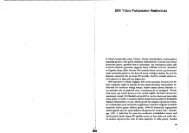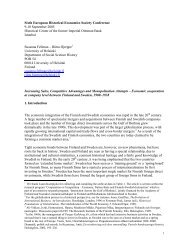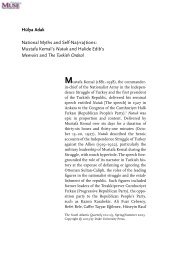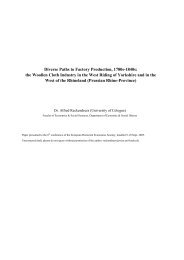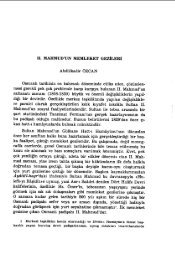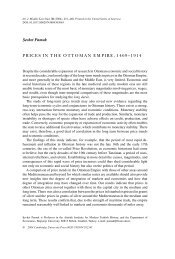The Birth of Insurance Contracts - The Ataturk Institute for Modern ...
The Birth of Insurance Contracts - The Ataturk Institute for Modern ...
The Birth of Insurance Contracts - The Ataturk Institute for Modern ...
Create successful ePaper yourself
Turn your PDF publications into a flip-book with our unique Google optimized e-Paper software.
enemies” are assumed to be verifiable, the model considers two extreme scenarios regarding the<br />
ability <strong>of</strong> the State to verify the commercial return. Under hidden in<strong>for</strong>mation the commercial<br />
returns is non-verifiable, at any cost, but the State can <strong>for</strong>ce the merchant pay out the minimum<br />
possible commercial return, x. Under the full in<strong>for</strong>mation structure the commercial return is<br />
verifiable without any private cost <strong>for</strong> the financier.<br />
2.1 <strong>Contracts</strong><br />
We consider allocations that can be obtained by means <strong>of</strong> a contract enabling the funding <strong>of</strong><br />
the venture and specifying transfers from the merchant to the financier both at the first and<br />
at the second date. Whereas first-date transfers τ ∈ ℜ are prior to the realization <strong>of</strong> the state<br />
and, accordingly, are independent <strong>of</strong> it, second-date transfers τ(s) are contingent on the state.<br />
A contract will result in consumption schedules <strong>for</strong> the merchant and the financier, c1 and c2<br />
respectively, where c1 := c1(s) = k1 − k + s − [τ + τ(s)] and c2 := c2(s) = k2 + [τ + τ(s)]. 6<br />
Sometimes the merchant lacked the capital required to undertake a sea venture. Others,<br />
however, he was a man <strong>of</strong> substance who could fund the venture he managed in whole or in part<br />
if he so wished. 7 Let φ k, with φ ∈ [0, 1] denotes the capital contributed by the merchant to the<br />
venture, so that (1 − φ)k ∈ [0, k] is the capital raised from the investor.<br />
During the twelfth and thirteenth centuries, merchants typically relied on sea loans and com-<br />
menda contracts, even when they were endowed with the resources required to finance the venture<br />
6 <strong>The</strong>se consumption schedules capture the fact that the venture’s returns first accrued to the merchant, who need<br />
to cover the fix cost k to generate the return s. This notation is better suited <strong>for</strong> the case in which the merchant<br />
owned the venture and hence was the residual claimant. Alternatively, consumption schedules can be expressed as<br />
c1(s) = k1 + ˘τ + ˘τ(s) and c2(s) = k2 − k + s − ˘τ − ˘τ(s), where ˘τ + ˘τ(s) = [−k − τ] + [s − τ(s)] are to be understood<br />
as a contingent salary the financier pays to the the merchant <strong>for</strong> handling his business abroad. It is worth noting<br />
that ownership is irrelevant to the model’s results. This is so because, on the one hand, the model is robust to the<br />
allocation <strong>of</strong> property rights (it considers all levels <strong>of</strong> bargaining power subject to individual rationality) and, on<br />
the other hand, there is no incomplete contracting and hence the allocation <strong>of</strong> control rights is unimportant.<br />
7 As the Consolat del Mar <strong>of</strong> Barcelona pointed out many merchants were propertyless men who owned nothing<br />
on their own among all that they carried (Pryor, 1983, p.162). We know, however, about many merchants with<br />
considerable assets. For example, according to the the estimo <strong>of</strong> 1207, Zaccaria Stagnario was among the richest<br />
men in Venice, yet he raised substantial amounts through commenda contracts to finance his numerous trips to<br />
the Levant (Buenger, 1999). Examples <strong>of</strong> merchants who invested in other merchant’s ventures abound. <strong>The</strong><br />
extant Venetian documentation <strong>for</strong> he period 1021-1261 make reference to 435 sea loans and commenda contracts<br />
in which 233 merchants are mentioned. Excluding the merchants who appear only once, and could not hence show<br />
up per<strong>for</strong>ming both roles, 36 percent <strong>of</strong> the merchants invested in other merchants’ ventures and over 72 percent<br />
<strong>of</strong> the 83 merchant’s families who appear twice or <strong>of</strong>tener had members who acted as merchants and members who<br />
acted as investors (Morozzo della Rocca and Lombardo, 1940 and 1953, and González de Lara, 2005, p. 21).<br />
6



